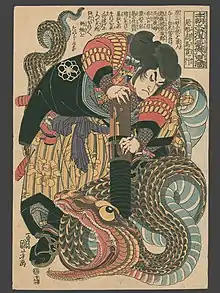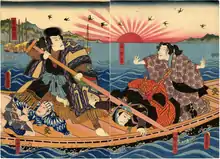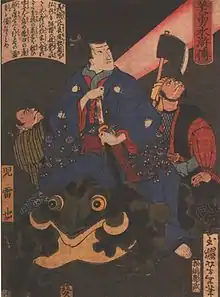Jiraiya
Jiraiya (自来也 or 児雷也, literally "Young Thunder"[1]), originally known as Ogata Shuma Hiroyuki, is the toad-riding protagonist of the Japanese folk tale Jiraiya Gōketsu Monogatari (児雷也豪傑物語, "The Tale of the Gallant Jiraiya"). The tale was adapted into a 19th-century serial novel, a kabuki drama, several films, video games, and a manga and has also influenced various other works.

Classic tale

In the legend, Jiraiya is a ninja who uses shapeshifting magic to morph into a gigantic toad. As the heir of the mighty Ogata clan in Kyūshū, Jiraiya fell in love with Tsunade (綱手), a beautiful young maiden who has mastered slug magic. His arch-enemy was his one-time follower Yashagorō (夜叉五郎), later known as Orochimaru (大蛇丸), a master of serpent magic (the kanji 大蛇 literally means "giant snake" or "serpent"). It was first recorded in 1806.

A novel version of the story was written by different authors and published in 43 installments from 1839 to 1868; one of its illustrators was woodblock artist Kunisada.[2] Kawatake Mokuami wrote a kabuki drama based on the first ten parts of the novel, which premiered in Edo in 1852, starring Ichikawa Danjūrō VIII in the leading role.[2]
Translations
The tale was translated as Jiraya, or the Magic Frog by author William Elliot Griffis.[3]
Legacy and influence
The story of Jiraiya inspired three homonymous characters from the manga and anime series Naruto.
A Persona representing the spirit of Jiraiya is also summoned by the character Yosuke Hanamura in Persona 4.
The 18th Super Sentai season, Ninja Sentai Kakuranger features a character named Jiraiya (played by Kane Kosugi ) who summons a giant toad mecha.
References
- "The Tale of Jiraiya the Gallant". Way Of Ninja. 2008-09-03. Retrieved 2013-09-18.
- "The Gallant Jiraiya". 2001-07-13. Archived from the original on July 13, 2001. Retrieved 2013-09-18.
- Griffis, William Elliot. Japanese Fairy World: Stories from the Wonder-lore of Japan. J. H. Barhyte. 1880. pp. 126-140.